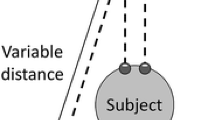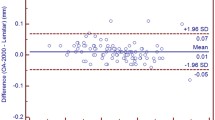Abstract
Purpose
To evaluate ocular biometric changes with different accommodative stimuli using a new swept-source optical biometer.
Methods
Only the right eye was analyzed. Each subject was measured six times with the IOLMaster 700 swept-source optical biometer (Carl Zeiss Meditec, Jena, Germany) with the subject looking at the stimulus shown by the instrument and with the subject looking at a target placed outside the instrument at 0D of vergence. Axial length (AL), anterior chamber depth (ACD), central corneal thickness (CCT), lens thickness (LT), white-to-white (WTW), and keratometry readings (K1 and K2) were evaluated in both cases. To assess if the changes found may affect the intraocular (IOL) power calculation for surgical applications, we have applied some formulae, using the software provided by the optical biometer manufacturer, to the ocular parameters found in both situations for three different types of IOLs.
Results
No statistically significant differences were found for AL, CCT, WTW, K1 and K2 between the subject looking at the stimulus of the biometer and looking at the outside target at 0D of vergence (p > 0.05). However, the measurement of ACD revealed a statistically significant reduction of 20 microns (p = 0.03) and, on the contrary, LT increased significantly 30 microns (p = 0.02). ACD and LT changes were highly correlated (R2 = 0.91). As for the IOL power calculation, in all cases, the mean change was lower than 0.25 D both for IOL power selection and residual refraction.
Conclusions
Although ACD and LT change significantly with different accommodative stimuli measured by swept-source optical biometry, these changes are not clinically relevant.



Similar content being viewed by others
References
Montés-Micó R, Carones F, Buttacchio A, Ferrer-Blasco T, Madrid-Costa D (2011) Comparison of immersion ultrasound, partial coherence interferometry, and low coherence reflectometry for ocular biometry in cataract patients. J Refract Surg 27:665–671
Srivannaboon S, Chirapapaisan C, Chonpimai P, Loket S (2015) Clinical comparison of a new swept-source optical coherence tomography-based optical biometer and a time-domain optical coherence tomography-based optical biometer. J Cataract Refract Surg 41:2224–2232
Kunert KS, Peter M, Blum M, Haigis W, Sekundo W, Schütze J, Büehren T (2016) Repeatability and agreement in optical biometry of a new swept-source optical coherence tomography-based biometer versus partial coherence interferometry and optical low-coherence reflectometry. J Cataract Refract Surg 42:76–83
Akman A, Asena L, Güngör SG (2016) Evaluation and comparison of the new swept source OCT-based IOLMaster 700 with the IOLMaster 500. Br J Ophthalmol 100:1201–1205
McAlinden C, Khadka J, Pesudovs K (2011) Statistical methods for conducting agreement (comparison of clinical tests) and precision (repeatability or reproducibility) studies in optometry and ophthalmology. Ophthal Physiol Opt 31:330–338
Montés-Micó R, Alió J, Muñoz G, Charman W (2004) Temporal changes in optical quality of air-tear film interface at anterior cornea after blink. Invest Ophthalmol Vis Sci 45:1752–1757
Sisó-Fuertes I, Domínguez-Vicent A, del Águila-Carrasco A, Ferrer-Blasco T, Montés-Micó R (2015) Corneal changes with accommodation using dual Scheimpflug photography. J Cataract Refract Surg 41:981–989
Ostrin L, Kasthurirangan S, Win-Hall D, Glasser A (2006) Simultaneous measurements of refraction and A-scan biometry during accommodation in humans. Optom Vis Sci 83:657–665
Bolz M, Prinz A, Drexler W, Findl O (2007) Linear relationship of refractive and biometric lenticular changes during accommodation in emmetropic and myopic eyes. Br J Ophthalmol 91:360–365
Richdale K, Bullimore MA, Zadnik K (2008) Lens thickness with age and accommodation by optical coherence tomography. Ophthalmic Physiol Opt 28:441–447
Cao HJ, Huang CJ, Shih PJ, Wang IJ, Yen JY. (2015) A method of measuring corneal Young’s modulus. In: 7th WACBE world congress on bioengineering. IFMBE Proceedings, vol 52, pp 47–50
Hamilton KE, Pye DC (2008) Young’s modulus in normal corneas and the effect on applanation tonometry. Optom Vis Sci 85:445–450
Jones IL, Warner M, Stevens JD (1992) Mathematical modelling of the elastic properties of retina: a determination of Young’s modulus. Eye (London) 6:556–559
Funding
Authors acknowledge financial support from the Spanish Government Grant Explora (SAF2013-49284-EXP) and a “Formación de Profesorado Universitario” Grant (FPU13/05332, Ministerio de Educación, Cultura y Deporte) awarded to Daniel Monsálvez-Romín.
Author information
Authors and Affiliations
Corresponding author
Ethics declarations
Conflict of interest
The authors declare no conflict of interest.
Ethical approval
All procedures performed in studies involving human participants were in accordance with the ethical standards of the institutional and/or national research committee and with the 1964 Helsinki declaration and its later amendments or comparable ethical standards.
Informed consent
Informed consent was obtained from all individual participants included in the study.
Rights and permissions
About this article
Cite this article
Ferrer-Blasco, T., Esteve-Taboada, J.J., Monsálvez-Romín, D. et al. Ocular biometric changes with different accommodative stimuli using swept-source optical coherence tomography. Int Ophthalmol 39, 303–310 (2019). https://doi.org/10.1007/s10792-017-0813-y
Received:
Accepted:
Published:
Issue Date:
DOI: https://doi.org/10.1007/s10792-017-0813-y




